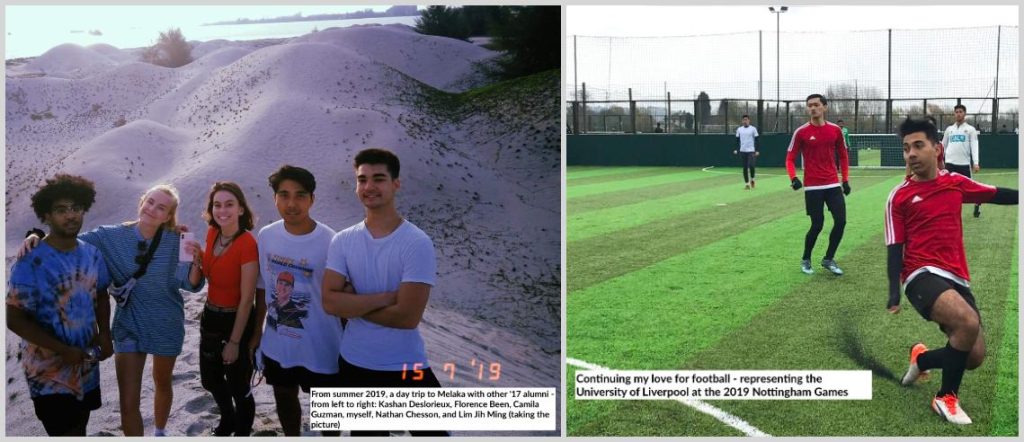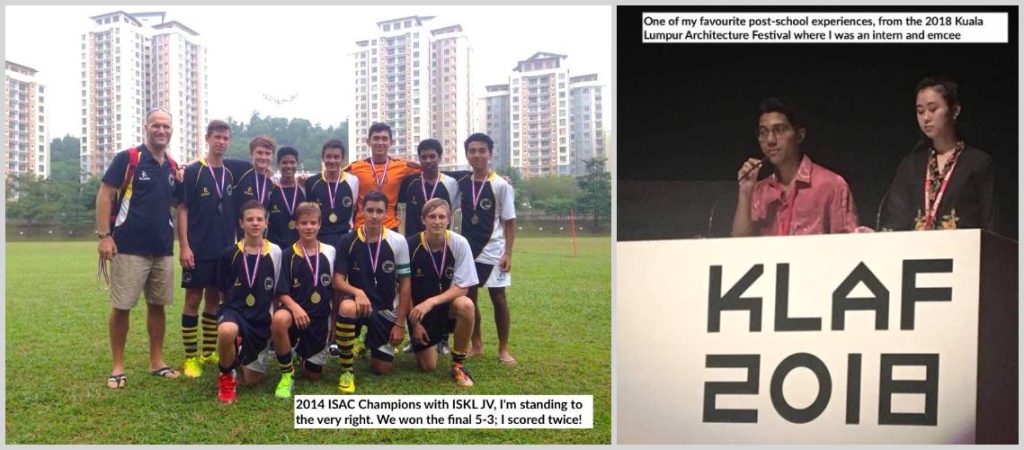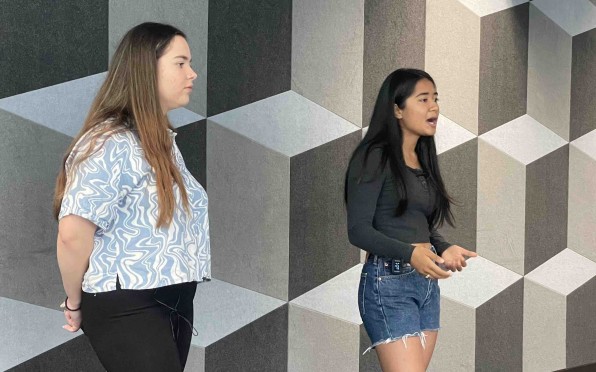It was his Grade 10 History teacher who advised Haziq Khairi (‘17) to find his academic passion and be driven by it, a message he lives by to this day. Having recently graduated with a First Class Degree in Architecture from the University of Liverpool, Haziq’s schoolyard passion for football has been eclipsed by a drive to design a better way of living.
Now undertaking an internship researching how Merseyside mental health facilities have adapted to the Covid-19 pandemic,
Haziq shares his love of architecture and memories of ISKL with ISKL’s Director of Development and Alumni Engagement, Lynette MacDonald.
LM: You have lived in several countries but are Malaysian. Tell us about your travels as a diplomat’s child?

HK: I was born in Kota Bharu, a smaller city in the north of Peninsular Malaysia. My dad is a diplomat, so when I was only a few months old we moved to Washington, D.C. where he worked at the Embassy of Malaysia. As other third culture kids might relate, this moving became a constant theme throughout my childhood. We returned to KL in 2004, staying for 3 years, and it was during this period when my older brother, Aqil, myself, and my younger sister Nayli all first enrolled at ISKL.
It wasn’t long before we were back on the move, this time to Ho Chi Minh City in 2007. We spent 4 years there before once again returning to KL for another 4 years; in 2015, I left ISKL for the final time as my family moved to Havana, Cuba, where my dad was Ambassador. I lived in Havana for two years, where I did the IB and eventually graduated in 2017.
LM: What impact did ISKL teachers, or the curriculum, have on your decision to pursue architecture?
HK: I’ve always had a strong interest in design – I remember as a little kid I would spend a lot of time drawing whatever buildings or cars I could conjure up in my head. At ISKL I took a lot of arts and drama classes, which consistently gave me a creative outlet, but somewhat ironically it wasn’t until I took a technical drawing class in 10th grade that my interests in drawing and architecture were really cemented as a potential career path. In my first year at university all our drawings had to be done by hand, so I didn’t have to wait too long before I could apply these skills I had begun learning at ISKL.
I’m not sure Mr. Whiting, my P.E. teacher and football coach for many years, was ever aware of my architectural interests, but he was always a strong positive influence and motivator for me. Additionally, I can thank Mr. Fisher, my 10th grade History teacher, for one of my most important memories from ISKL. I still recall what he wrote in my report card that year: “You have the potential to be an amazing student. Find your academic passion and be driven by it.” Today, I really can’t see myself pursuing anything other than architecture and his words gave me the inspiration and desire to find this passion.
LM: What are your particular areas of interest in architecture?
HK: This is likely some consequence of my upbringing in various countries, but I have always been intrigued by the characteristics of architecture that defines place. To use an example many of us are familiar with, the Twin Towers at KLCC reference Islamic motifs as a reflection of its location within a Muslim-majority country, and as a result it is difficult to imagine it placed anywhere else. I find that the strongest architecture is often that which is contextual, an evolution of what has come before.
More recently, I’ve been greatly enthused by Postmodern architecture, which was originally conceived as a tongue-in-cheek revolt to the austerity and formality of Modernist architecture. Postmodernism is a style that references the past but often in a loose, playful manner, without taking itself too seriously; and this is an approach I’m looking to draw from for my own work.
However, architecture is a lot more than buildings. From its most idealistic position, it is a means towards a better way of living. To get there, I have to learn about sustainability, representation, graphic design, mapping, history, writing…it is an incredibly multifaceted and diverse field, which is exciting as I am virtually guaranteed to never run out of things to experience and take an interest in.
LM: Congratulations! You have had a very successful year. You received the University of Liverpool (UoL) School of the Arts Academic Achievement Award and your final third year studio project – for a high-density, intergenerational housing scheme – was nominated for the Sheppard Robson Jicwood Prize. On top of that, you received the Holt Travelling Scholarship towards an architecture-themed study trip and you’re planning, when it’s safe, to visit Yale and Harvard. Why have you chosen those universities?
HK: In my second year at university, I had to propose a new headquarters for the Royal Institute of British Architects in Liverpool. My scheme was heavily influenced by the twentieth-century buildings at these campuses, especially those designed by the famous Modernist architects Le Corbusier and Louis Kahn.
Some might consider it to be a rite of passage as an architect to go for a Modernist pilgrimage, so as part of mine I hope to visit, in particular, the Carpenter Center at Harvard and Yale’s Art Gallery and Centre for British Art. Despite the many flaws of the Modernist movement I have always been fascinated by the theory behind it and the American Northeast is littered with many salient and beautiful examples.

LM: Tell me some more about your internship with UoL. I am particularly interested to hear your initial observations about the impacts of Covid-19 on mental health services and efforts to adapt facilities to meet new restrictions.
One of the key aspects we’re focusing on is a recent trend of building reuse in the development of these facilities, as opposed to the construction of new purpose-built units. Mersey Care – an NHS Trust specialising in mental health care – operates a service called the Life Rooms, which are housed in a range of refurbished and remodeled buildings; from libraries to churches to theatres.
With the pandemic, however, the Life Rooms have actually remained closed since March, and staff have had to adapt their services and programmes to an online format. This was initially intended as a temporary measure, but it has proved so effective that Mersey Care are planning to instate it as a permanent service when their buildings can reopen.
So with the pandemic highlighting the viability of virtual treatment services, how will this factor into the design processes architects take when designing mental health facilities in the future? How will older buildings adapt to fulfill these contemporary requirements? Where does all this fit in the reuse vs. new-build debate? Amidst a backdrop of sustainability and climate change, questions like these are becoming increasingly pertinent within architectural discourse.
LM: Where would you like to live and work and why?
HK: Honestly, I would be content for now to continue the nomadic lifestyle of my childhood. I’m in the UK now, but my brother is in Seattle, my parents are in KL, and my friends are scattered everywhere. I’m open to anywhere as long as the opportunity is right.
When I’m older though, I’d definitely like to settle down and design in Malaysia. I’d love the opportunity to contribute towards, and improve, the built environment of my home country.
LM: What are your favorite memories of your time at ISKL? Do you still stay in touch with other ISKL alumni?
HK: My fondest memories from ISKL are definitely of playing football, from U13s in middle school through to Junior Varsity in high school. There were many days when all I would look forward to were afternoon training sessions, lunchtime games at the Panther Pit or just a casual after-school session of Bums. I met most of my closest friends this way and today we are still in close contact, maintaining an active group chat for football discussion.
In the classroom, I particularly enjoyed my English classes. If the research article I’m currently working on does get published, I would definitely credit two of my teachers – Ms. Sarnacki and Mr. Hemmens – for fostering my love for reading and writing.
Since my parents have been in KL since 2018, I would always return to Malaysia for my university summer holidays, and so I have been able to spend time with my ISKL friends on these visits. Architecture, however, is an incredibly time intensive course, so in the UK I never had as much time as I would have liked to travel around the country. Nevertheless, I did manage to squeeze in trips to London, Manchester, Nottingham and Sheffield to visit other Class of ’17 alumni back in first year when I wasn’t so busy.










